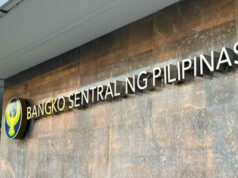Yields on BSP securities go down following latest cut in benchmark rates

YIELDS on the Bangko Sentral ng Pilipinas’ (BSP) short-term securities ended lower on Friday after it delivered its third straight rate cut.
The BSP bills fetched bids amounting to P83.946 billion on Friday, well below the P120-billion offer as both tenors were undersubscribed. However, this was higher than the P59.557 billion in tenders for the P100 billion auctioned off the week prior.
The central bank accepted all the submitted bids for the one-month and two-month securities.
Broken down, tenders for the 28-day BSP bills reached P39.812 billion, below the P50-billion placed on the auction block but above the P17.921 billion in bids seen for the P40 billion offered the prior week.
Accepted yields were from 5.16% to 5.41%, a wider and lower range compared to the 5.34% to 5.42% margin seen a week prior. With this, the weighted average accepted rate of the one-month securities fell by 4.56 basis points (bps) to 5.3328% from 5.3784% previously.
Meanwhile, bids for the 56-day securities amounted to P44.134 billion, lower than the P70-billion offer but higher than the P41.636 billion in tenders for the P60 billion offered in the previous week’s auction.
Banks asked for rates ranging from 5.19% to 5.42%, widening from the 5.358% to 5.4% spread seen a week earlier. This caused the average rate of the two-month securities to decline by 4.67 bps to 5.3382% from 5.3849% logged a week prior.
“Weighted average interest rates fell following the policy rate cut announced the day prior,” the BSP said in a statement on Friday.
This also came even as both tenors went undersubscribe after the central bank increased the total volume on offer.
On Thursday, the Monetary Board reduced its target reverse repurchase rate by 25 bps for a third straight meeting to 5%, as expected by all 20 analysts in a BusinessWorld poll.
The BSP has so far slashed borrowing costs by a cumulative 150 bps since it began its easing cycle in August 2024.
BSP Governor Eli M. Remolona, Jr. said they could deliver one more 25-bp cut this year to support the economy if needed, which could mark the end of their current easing cycle.
The Monetary Board has two remaining meetings this year to be held in October and December.
The central bank uses the BSP securities and its term deposit facility to mop up excess liquidity in the financial system and to better guide short-term market rates towards its policy rate.
The BSP bills also contribute to improved price discovery for debt instruments while supporting monetary policy transmission, the central bank said.
The central bank securities were calibrated to not overlap with the Treasury bill and term deposit tenors also being offered weekly.
Data from the central bank showed that around 50% of its market operations are done through its short-term securities.
The BSP bills are considered high-quality liquid assets for the computation of banks’ liquidity coverage ratio, net stable funding ratio, and minimum liquidity ratio. They can also be traded on the secondary market. — Katherine K. Chan



